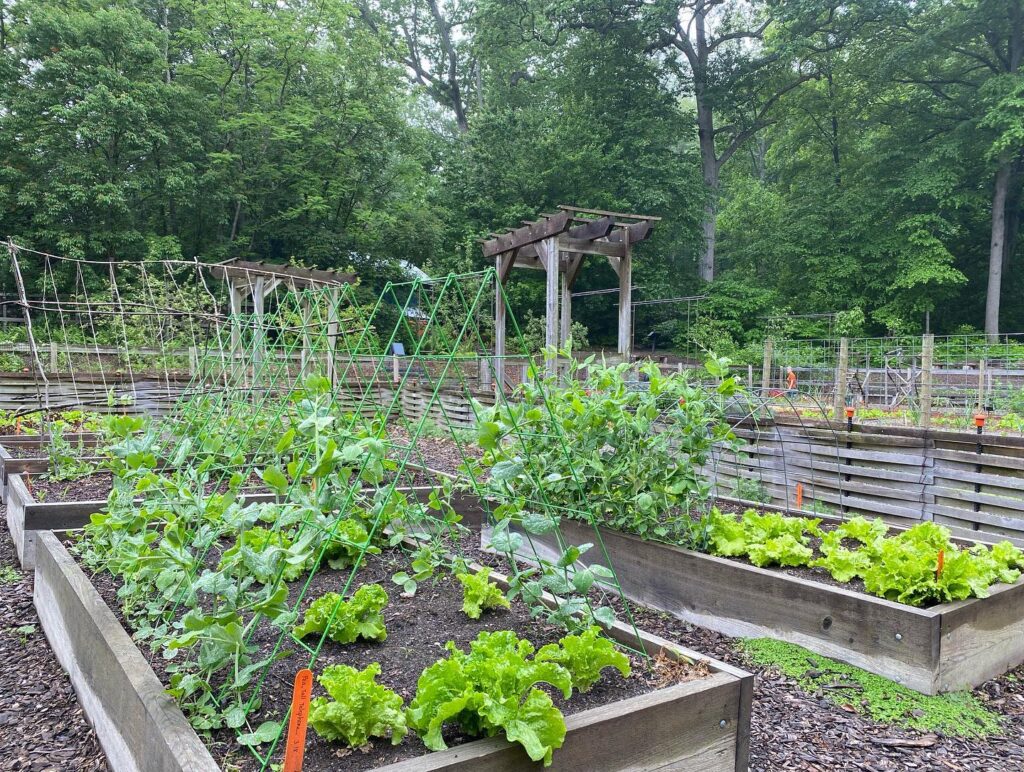Square foot gardening is the way to go if you are short on time and space but still want to grow plenty of your own food to eat. With this method, you can potentially grow 100% of the crops in only 20% of the space needed for an in-ground row garden.
Square foot gardening was developed by Mel Bartholomew 40 years ago. His method is to garden in a raised bed, which you then plot out in one-foot squares. This technique also uses vertical space with cages and trellises to support vining plants.
Let’s get to the meat of the technique, or should a say, let’s turn over a new leaf:
- Get Your Grow Space – first, build or buy a four-by-four foot raised bed lined with a weed barrier landscaping fabric if you want fewer weeds and are building on top of other soil. Raised beds placed atop your lawn or soil should be six inches deep or, if placed on a solid surface, at least 12 inches deep.
- Put In Your Soil – fill your raised bed with your growing medium. Soil should be six inches deep, or you may want to fill your raised bed using the “Lasagna Method.” Begin with a thick layer of cardboard to help smother weeds beneath the bed. Then add small sticks or branches you have around the yard. Then alternate between layers of nitrogen and carbon materials. Nitrogen materials are wet and often fresh materials such as vegetable scraps, fresh grass clippings, coffee grounds, seaweed, and manure. Carbon materials are dry and usually brown, such as paper, cardboard, wood chips, shavings, bark, straw, and dry leaves. Finally, top with one to three inches of compost or topsoil.
- Lay Out Your Grid – overlay a square foot grid using twine or long thin slats of wood, which are then cross-thatched into one-foot squares.
- Plant seeds or seedlings – according to the following metric:
One plant at the center per square foot: celery, corn, eggplant, kale, lettuce (head), okra, oregano, parsley, peppers, potatoes, rosemary, and tomatoes (staked). This will leave you with one plant per square foot or a total of four plants per garden.
OR
Two plants side by side per square foot: cantaloupe, cucumbers, pumpkins, watermelons, winter squash, broccoli, Brussel sprouts, cabbage, and cauliflower. Any vining crops should be trellised to grow vertically This will leave you with a total two plants per square foot and eight plants per garden.
OR
One plant in the four corners of each square foot when planting: basil, garlic, kohlrabi, leeks, lettuce (leaf), onions, winter radishes, rutabaga, summer squash (with cage), Swiss chard, and zucchini (with trellised support) This will leave you with a total of four plants per square foot, totaling 16 plants per garden.
OR
Eight or nine plants per square foot with two to three seeds or plants on the border of each side of the square, equidistant apart when planting green beans (bush or pole), beets, cilantro, garlic, leeks, onions, peas, spinach, and turnips. This will leave you with eight plants per square foot, totaling 32 plants per garden.
OR
Sixteen seeds or plants per square foot when planting carrots, parsnips, and radishes. This will leave you with a total of 16 plants per square foot and 64 plants per garden.
Perennial vegetables are not appropriate for square foot gardening because they need a large space or tend to overshadow other vegetables in proximity. These include artichokes, asparagus, and rhubarb.
If you want more details regarding specific vegetables to plant in your square foot garden, borrow from the library or purchase a copy of Mel Bartholomew’s book, All New Square Foot Gardening (3rd edition). You can also find plenty of online resources for square foot garden planning.
Next you need to start your seeds. First, form holes in each square using your finger, correlating to the number of plants you will be growing in that square. Make sure the holes are equidistant in each square. Plant two to three seeds of your chosen vegetable in each hole. Cover lightly with soil, then water. Once sprouted, choose the strongest-looking seedlings from each set of two to three seeds you have planted and remove the other to give the one seedling clearance. This will become your final, full-grown vegetable or herb!
A cup and a bucket are all that is needed to water your square foot garden. That’s right, you don’t need to soak the entire area with a hose or a watering can. Most plants do better when watered directly at their base.
Don’t forget to mulch your bed. This will make for less weeding and more moisture retention whenever you water, or it rains.
Last but not least, enjoy your abundant harvest! Now that the world has gotten busier, food prices have risen, and inflation continues to soar, it is a fine time to work less and enjoy more. So, enjoy the efficiency of your small space garden!







